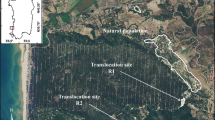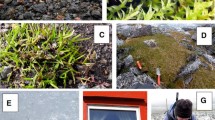Abstract
Lichen translocation techniques that may be of value in the salvage of endangered lichen species, or in the latter stages of habitat restoration, are reviewed. Successful translocation is defined here as the transfer of a target organism from a donor site to a receptor site to establish a new self-maintaining colony; for lichens, this may or may not include co-transfer of the thallus-supporting substrate. In a time of global environmental change many species are under threat and the need for effective translocation methods is clear. Indeed, some lichens are already amenable to translocation from one substrate to another. Global conservation requires the restoration of degraded ecosystems and translocation technology offers a tool for habitat replenishment. The re-introduction of lichenised fungi into sites from which they have been lost is an integral part of the restoration of complex habitats. Successful translocation creates in turn niches for other organisms which inhabit, or feed upon, them.
Similar content being viewed by others
References
Armstrong RA (1984) Growth of experimentally reconstructed thalli of the lichen Parmelia conspersa. New Phytol 98:497–502
Armstrong RA (1993) The growth of six saxicolous lichens transplanted to lime-rich and lime-poor substrates in South Gwynedd, Wales. Symbiosis 15:257–267
Armstrong RA (1994) The influence of bird droppings on the growth of lichen fragments transplanted to slate and cement substrates. Symbiosis 17:75–86
Bern Convention (1979) The convention on the conservation of European wildlife and natural habitats. Adopted in Bern, Switzerland in 1979. http://conventions.coe.int/Treaty/EN/Treaties/Html/104.htm. Accessed 7 January 2014
Boch S, Prati D, Werth S, Rüetschi J, Fischer M (2011) Lichen endozoochory by snails. PLoS ONE 6(4). http://www.plosone.org/article/info:doi/10.1371/journal.pone.0018770. Accessed 9 October 2013
Brodo IM (1961) Transplant experiments with corticolous lichens using a new technique. Ecology 42:838–841
Brooker R, Britton A, Gimona A, Lennon J, Littlewood N (2011) Literature review: species translocations as a tool for biodiversity conservation during climate change. Scottish Natural Heritage Commissioned Report No. 440. http://www.snh.org.uk/pdfs/publications/commissioned_reports/440.pdf. Accessed 9 October 2013
Butchart SHM, Walpole M, Collen B, van Strien A, Scharlemann JPW, Almond REA, Baillie JEM, Bomhard B, Brown C, Bruno J, Carpenter KE, Carr GM, Chanson J, Chenery AM, Csirke J, Davidson NC, Dentener F, Foster M, Galli A, Galloway JN, Genovesi P, Gregory RD, Hockings M, Kapos V, Lamarque J-F, Leverington F, Loh J, McGeoch MA, McRae L, Minasyan A, Morcillo MH, Oldfield TEE, Pauly D, Quader S, Revenga C, Sauer JR, Skolnik B, Spear D, Stanwell-Smith D, Stuart SN, Symes A, Tierney M, Tyrrell TD, Vié J-C, Watson R (2010) Global biodiversity: indicators of recent declines. Science 328:1164–1168
CBD (1992) Convention on biological diversity. http://www.cbd.int/convention/text/. Accessed 7 January 2014
CBD (2010) Convention on biological diversity. Strategic plan for biodiversity 2011 – 2020, including Aichi biodiversity targets. http://www.cbd.int/sp/. Accessed 7 January 2014
Christ R, Türk R (1981) Die Indikation von Luftverunreinihungen durch CO2 – Gaswechsel-messungen an Flechtentransplantaten. Mitt Forstl Bundesversuchsanstalt 137:145–150
Crowther K, Bliss A, Smith P (2009) Adder’s-tongue: a 13-year translocation story. In Practice (Bull Chart Inst Ecol Environ Manag) 64:18–22
Denison WC (1988) Culturing the lichens Lobaria oregana and L. pulmonaria on nylon monofilament. Mycologia 80:811–814
Ellin SJ (1990) Epiphytic lichens and air pollution: effects of sulphur dioxide, ozone and wet acidic deposition, singly or in combination, under field and solardome conditions on foliose and fruticose lichen species with green photobionts. PhD thesis, University of Bradford
Farkas E, Lokös L, Verseghy K (1985) Lichen as indicator of air pollution in the Budapest agglomeration. Acta Bot Hung 31:45–68
Galun M, Ronen R (1988) Interactions of lichens and pollutants. In: Galun M (ed) Handbook of lichenology, volume 3. CRC Press, Boca Raton, pp 55–72
Gilbert OL (1977) Lichen conservation in Britain. In: Seaward MRD (ed) Lichen ecology. Academic Press, London, pp 415–436
Gilbert OL (1988) Colonisation by Parmelia saxatilis transplanted onto a suburban wall during declining SO2 pollution. Lichenologist 20:197–198
Gilbert OL (1991) A successful transplant operation involving Lobaria amplissima. Lichenologist 23:73–76
Gilbert OL (1997) Golden hair lichen transplant trials (Teloschistes flavicans). Species recovery programme report to English Nature (unpublished – contains, or is based on, information supplied by Natural England)
Gilbert OL (2000) Lichens. HarperCollins, London
Gilbert OL (2001a) Species recovery programme: The Breckland rarities and Teloschistes flavicans. In: Fletcher A (ed) Lichen habitat management. British Lichen Society, London
Gilbert OL (2001b) Golden hair lichen transplant monitoring: Summary of year four (summer 2000 to summer 2001). Species recovery programme report to English Nature (unpublished – contains, or is based on, information supplied by Natural England)
Gilbert OL (2002) A transplant operation involving Lobaria amplissima: the first twenty years. Lichenologist 34:267–272
Hale ME (1954) First report on lichen growth rate and succession at Aton Forest, Connecticut. Bryologist 57:244–247
Hale ME (1959) Studies on lichen growth rate and succession. Bull Torrey Bot Club 86:126–129
Hallingbäck T (1990) Transplanting Lobaria pulmonaria to new localities and a review on the transplanting of lichens. Windahlia 18:57–64
Hallingbäck T, Ingelög T (1989) Åtgärder för att bevara luftföroreningskänslig lav-och mossflora. Naturvårdsverket. Rapport 3679. Stockholm
Hawksworth DL (1971) Lobaria pulmonaria (L.) Hoffm. transplanted into Dovedale, Derbyshire. Naturalist 96:127–128
Hazell P, Gustafsson L (1999) Retention of trees at final harvest: evaluation of a conservation technique using epiphytic bryophyte and lichen transplants. Biol Conserv 90:133–142
Hilmo O (2002) Growth and morphological response of old-forest lichens transplanted into a young and an old Picea abies forest. Ecography 25:329–335
Hilmo O, Ott S (2002) Juvenile development of the cyanolichen Lobaria scrobiculata and the green algal lichens Platismatia glauca and Platismatia norvegica in a boreal Picea abies forest. Plant Biol 4:273–280
Hoegh-Guldberg O, Hughes L, McIntyre S, Lindenmayer DB, Parmesan C, Possingham HP, Thomas CD (2008) Assisted colonization and rapid climate change. Science 321:345–346
Hoffman GR (1971) Bark samplers for use in air pollution-epiphytic cryptogram studies. Bryologist 74:490–493
Honegger R (1993) A simple outdoor culturing system for the foliose macrolichens Xanthoria parietina (L.) Th. Fr. and Parmelia sulcata Tayl. Bot Helv 103:223–229
Honegger R (1995) Experimental studies with foliose macrolichens: fungal responses to spatial disturbance at the organismic level and to spatial problems at the cellular level during drought stress events. Can J Bot 73:569–578
Honegger R (1996) Experimental studies of growth and regenerative capacity in the foliose lichen Xanthoria parietina. New Phytol 133:573–581
IUCN [International Union for Conservation of Nature] (1998) Guidelines for re-introductions. Prepared by the IUCN/SSC Re-introduction Specialist Group. Gland and Cambridge: IUCN
Jahns HM (1993) Culture experiments with lichens. Plant Syst Evol 187:145–174
Jansson KU, Palmqvist K, Esseen P-A (2009) Growth of the old forest lichen Usnea longissima at forest edges. Lichenologist 41:663–672
JNCC [Joint Nature Conservation Committee] (2003) A policy for conservation translocations of species in Britain. JNCC in conjunction with the Countryside Council for Wales, English Nature and Scottish Natural Heritage (drafted by IFG McLean) on behalf of the Inter-agency Translocations Working Group. http://jncc.defra.gov.uk/page-2920. Accessed 3 January 2014
JNCC [Joint Nature Conservation Committee] (2010) UK priority species data collation – Collema dichotomum: 1–15. http://jncc.defra.gov.uk/_speciespages/234.pdf. Accessed 7 January 2013
Kärenlampi L (1972) Reindeer lichens and the monitoring of the climate-caused ecosystem changes. IBP i Norden 9:51–61
Kon Y, Ohmura Y (2010) Regeneration of juvenile thalli from transplanted soredia of Parmotrema clavuliferum and Ramalina yasudae. Bull Natl Mus Nat Sci Ser B 36:65–70
Lawrey JD (1984) The biology of lichenized fungi. Praeger Scientific, New York
Le Blanc F, Rao DN (1966) Reaction de quelques lichens et mousses epiphytiques a 1’anhydride sulfureux dans la region de Sudbury, Ontario. Bryologist 69:338–345
Le Blanc F, Rao DN (1973) Effects of sulphur dioxide on lichen and moss transplants. Ecology 54:612–617
Lesher RD, Derr CC, Geiser LH (2003) Natural history and management considerations for northwest forest plan survey and manage lichens. USDA Forest Service Pacific Northwest Region Natural Resources Technical Paper, Portland, OR, R6-NR-S&M-TP-03-03, 211 p. pp. 65–70. http://www.blm.gov/or/plans/surveyandmanage/files/mr-nat_hist_and_mgmt_consid-li-2003.pdf. Accessed 7 January 2014
Lidén M, Pettersson M, Bergsten U, Lundmark T (2004) Artificial dispersal of endangered epiphytic lichens: a tool for conservation in boreal forest landscapes. Biol Conserv 118:431–442
Lindahl P-O (1953) The taxonomy and ecology of some Peltigera species, P. canina (L.) Willd., P. rufescens (Weis) Humb., P. praetextata (Flk.) Vain. Sven Bot Tidskr 47:94–106
McCarthy PM (1989) Observations on fragmentation and loss among lichen thalli. Proc Roy Ir Acad 89B:25–32
McCune B, Derr CC, Muir PS, Shirazi A, Sillett SC, Daly WJ (1996) Lichen pendants for transplant and growth experiments. Lichenologist 28:161–169
Richardson DHS (1967) The translocation of lichen thalli to solve some taxonomic problems in Xanthoria parietina (L.) Th. Fr. Lichenologist 3:386–391
Ronen R, Garty J, Galun M (1983) Air pollution monitored by lichens. Proc Int Meet Israel Ecol Soc Dev Ecol Environ Qual 2:167–176
Rose F (1992) Temperate forest management: Its effects on bryophyte and lichen floras and habitats. In: Bates JW, Farmer AM (eds) Bryophytes and lichens in a changing environment. Oxford University Press, Oxford
Roturier S, Bäcklund S, Sundén M, Bergsten U (2007) Influence of ground substrate on establishment of reindeer lichens after artificial dispersal. Silva Fenn 41:269–280
Scheidegger C (1995) Early development of transplanted isidioid soredia of Lobaria pulmonaria in an endangered population. Lichenologist 27:361–374
Scheidegger C, Werth S (2010) Conservation strategies for lichens: insights from population biology. Fungal Biol Rev 23:55–66
Scheidegger C, Frey B, Zoller S (1995) Transplantation of symbiotic propagules and thallus fragments: methods for the conservation of threatened epiphytic lichen populations. Mitt Eidgenöss Forsch Wald Schnee Landsch 70:41–62
Schenk G (1997) Moss gardening: including lichens, liverworts and other miniatures. Timber Press, Portland
Schönbeck H (1969) Eine methode zur Erfassung der biologischen Wirkung von Luftverunreinigungen durch transplantierte Flechten. Staub Reinhalt Luft 29:14–18
Schuster G, Ott S, Jahns HM (1985) Artificial cultures of lichens in the natural environment. Lichenologist 17:247–253
Seaward MRD (1976) Performance of Lecanora muralis in an urban environment. In: Brown DH, Hawksworth DL, Bailey RH (eds) Lichenology, problems and progress. Academic Press, London, pp 323–357
Secretariat of the Convention on Biological Diversity (2000) Sustaining life on Earth: How the Convention on Biological Diversity promotes nature and human well-being. Secretariat of the Convention on Biological Diversity with the support of the United Nations Environment Programme (UNEP) and the financial support of the Government of the United Kingdom. http://www.cbd.int/doc/publications/cbd-sustain-en.pdf. Accessed 7 January 2014
Sigal LL, Nash TH (1983) Lichen communities on conifers in southern California mountains: an ecological survey relative to oxidant air pollution. Ecology 64:1343–1354
Sillett SC, McCune B (1998) Survival and growth of cyanolichen transplants in Douglas-fir forest canopies. Bryologist 101:20–31
Smith PL (2013) Is it detrimental to lichens to move the bricks supporting them? In Practice (Bull Chart Inst Ecol Environ Manag) 80:27–30
Smith CW, Aptroot A, Coppins BJ, Fletcher A, Gilbert OL, James PW, Wolseley PA (2009) The lichens of Great Britain and Ireland. The British Lichen Society, London
Sonesson M, Sveinbjörnsson B, Tehler A, Carlsson BA (2007) A comparison of the physiology, anatomy and ribosomal DNA in alpine and subalpine populations of the lichen Nephroma arcticum – the effects of an eight-year transplant experiment. Bryologist 110:244–253
Walser J-C, Scheidegger C (2002) Transplanting lichen fragments for provenance-clone tests. In: Nimis PL, Scheidegger C, Wolseley PA (eds) Monitoring with lichens – monitoring lichens. NATO Science Series IV: Earth and Environmental Sciences 7. Kluwer, London, pp 385–390
Webster M, Brown DH (1997) Preliminary observations on the growth of transplanted Peltigera canina under semi-natural conditions. Lichenologist 29:91–96
Acknowledgments
The author wishes to thank Prof. Mark Seaward and Prof. David Richardson for their most valuable comments on earlier drafts of this paper, Dr Tomas Hallingbäck for information regarding the successful translocation of Lobaria pulmonaria by a simple rubbing technique, Dr Rob Brooker for information on Flavocetraria nivalis, and Chiska Derr for details of her work on Peltigera gowardii.
Author information
Authors and Affiliations
Corresponding author
Rights and permissions
About this article
Cite this article
Smith, P.L. Lichen translocation with reference to species conservation and habitat restoration. Symbiosis 62, 17–28 (2014). https://doi.org/10.1007/s13199-014-0269-z
Received:
Accepted:
Published:
Issue Date:
DOI: https://doi.org/10.1007/s13199-014-0269-z




